
Joseph Viscomi, “William Blake’s 1818 Letter to Dawson Turner and Later Career as Graphic Artist”
Blake printed approximately 157 copies of sixteen illuminated books between 1789 and June 1818. All but fourteen were printed by the end of 1795, by which time Blake had copies of all saleable books in stock and began taking on new “designing and painting” projects. In the twenty-three years between 1795 and 1818, Blake printed illuminated books only four times, for fourteen copies of four titles. In 1818, Blake received an enquiry from Dawson Turner for a “selection” of illuminated designs printed in colors like those Blake had produced for Ozias Humphry in 1796 and which are now known as the Large Book of Designs and Small Book of Designs. Blake refused and redirected Turner to illuminated books and large monoprints, none of which he purchased. Nevertheless, Blake’s letter to Turner marks the moment when Blake was willing to return to a body of work that, with very few exceptions, he had not touched in more than two decades and which he had explicitly declined to reprint in 1808. That decision in 1818, along with a commission from another collector shortly after he wrote Turner, made possible his resurgence in his last decade, as poet, publisher, illustrator, painter, and, equally significant, as original graphic artist. This essay examines Blake’s letter in detail to reveal why he refused Turner’s request, had stopped printing most of his illuminated books, and stopped color printing and monoprinting altogether. It reads the letter closely in light of Blake’s labor history to reveal the idea he had of himself as an artist, the attitude he had toward the hierarchy in the arts, and the works he believed made his “great reputation as an Artist.”
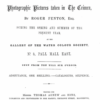
Peter H. Hoffenberg, “The Official Opening of ‘The Exhibition of the Photographic Pictures taken in The Crimea by Roger Fenton, Esq.'”
The first public exhibition of war photographs opened in London in late September 1855, during the costly and controversial Crimean War. The show introduced over 300 black and white images taken by well-known photographer Roger Fenton (1819-1869) and continued with various additions over the next several months in Britain. Later host cities included Manchester, Birmingham, and Belfast. Queen Victoria and Prince Albert were the leading sponsors of the shows. The first exhibition was well chronicled at the time, and this essay reviews some of those public contemporary responses, published primarily in major newspapers and periodicals, as well as in photographic society journals. Those responses are considered in light of the history of photography, mid-Victorian matters of art, science and war, and common conclusions at the time and that the show was primarily a work of propaganda to support the Crimean War and that Fenton’s images were not realistic.
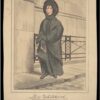
Rebecca Nesvet, “Miss Whitehead, ‘The Bank Nun’”
An urban legend maintains that early in the nineteenth century, one Miss Whitehead, colloquially known as “the Bank Nun,” frequently visited the Bank of England to accuse that institution of destroying her brother, a financial forger. This essay traces the evolution of this legend. I contend that in 1837, an obscure comic sketch reacted to that year’s major financial crisis by dredging up the Romantic-era case of financial forger Paul Whitehead and focusing on his surviving sister. Displacing her brother’s notoriety onto her, the sketch reinvents her as “the Bank Nun,” a grotesque magnet for lingering Romantic-era anxieties about the circulation of paper credit, financial forgery, and women. A succession of plagiarisms, retellings, and reappraisals of this ephemeral sketch and its portrait illustration made the Bank Nun a folk heroine of enduring resonance. Via this iconic figure, Romantic-era economic controversy haunts London today.
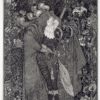
Sasha Dovzhyk, “The Queer Little Grove: The Adoption of Aubrey Beardsley by Mikhail Kuzmin”
This article explores one of the many aspects of Aubrey Beardsley’s (1872–1898) transnational legacy, focusing on his appropriation by Mikhail Kuzmin (1872–1936), a key modernist writer and a seminal voice of the emerging homosexual subculture in Russia. While Kuzmin often used Beardsley as a signifier of homoeroticism in his literary works and life-writing, it is in his play Little Grove (1922) that the queering of Beardsley is crystallized. My intermedial analysis of the piece will show how allusions to Beardsley shape Kuzmin’s representation of gender and sexuality and how the formal construction of Kuzmin’s publication echoes the formal features of Beardsley’s graphic designs.
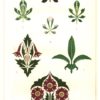
Irena Yamboliev, “Christopher Dresser, Physiological Ornamentist”
This article argues that, in 1862, when he published his most influential book The Art of Decorative Design, Christopher Dresser joined the multi-disciplinary enterprise of the physiological aesthetics in the name of ornamental form, positioning the theory of ornament as a crucial cutting edge of the empirical study of human aesthetic responses. I read The Art of Decorative Design in relation to contemporary psychological-aesthetics texts by Alexander Bain, Herbert Spencer, James Sully, Edmund Gurney, and Clementina Anstruther-Thomson and Vernon Lee to show that Dresser finds in ornamental form a site for a materialist physiological understanding of aesthetic response—and he does so well prior to the essays on aesthetics that were published in the journal Mind from the 1870s on. Like contemporary empirical aestheticists—and in distinction to other ornamentists of his time—Dresser emphasizes the mental “laws” that orchestrate our reactions to forms in nature and in ornament alike. Tracing in Dresser’s design handbook an approach to ornamental form that becomes fully “physiologized” in Bain’s, Sully’s, Gurney’s, and Lee’s writing makes more complete the critical picture of the so-called “lesser” (and often pejoratively feminized) decorative arts as a fertile ground for the theories and practices the empirical aestheticists were pursuing.
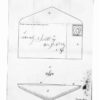
Jason Camlot, “The First Phonogramic Poem: Conceptions of Genre and Media Format, Circa 1888”
By 1888, the technology of the phonograph, and the medium of the phonograph cylinder, were established as market-ready. What was the imagined potential of this media technology in relation to known modes of communication and expression? This article recounts how “The Phonogram” or phonographic letter was prototyped from 1887 to 1892 through the efforts of Thomas Alva Edison and his London agent George Gouraud. Edison’s prototyping work and Gouraud’s efforts in developing recordings, scripts for phonogramic speeches, and formats for typographical transcription of the cylinder recordings represent a rich case study for documenting the nature and significance of their efforts to consolidate the medium and define the generic parameters of the phonogram (a speech recording) as a distinct form of global communication. By theorizing the relationship between late-Victorian concepts of medium, format and genre, respectively, and by interpreting the “first phonogramic poem” (16 June 1888) as an articulation of the meaning of sound recording at the historical moment that it arrived as a viable media technology, this article helps explain how sound recording technologies were imagined in relation to specific genres of communication. Drawing upon periodical literature, and documentation available through the Thomas Edison Papers archive—including phonogramic transcripts and speeches, marketing and foreign business strategies, patent applications, and packaging and design documents—this article explains, in particular, the generic and rhetorical protocols that informed the attempt to establish the phonogram as a new medium of intimate communication and international correspondence.
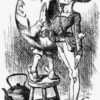
Jean Little, “Algebraic Logic in Through the Looking Glass”
This essay argues that Lewis Carroll’s Through the Looking Glass, which was published December 27, 1871, refers repeatedly to mathematics and logic in ways that, while certainly playful, reflect a careful thinking through of Boolean logic. Just as George Boole’s symbolic algebra relies on relational and oppositional binaries to create an internally coherent system, Through the Looking Glass experiments with binaries in their various forms, often using the numbers zero and one as placeholders for more complex ideas. This model of logic as a systematic grouping of concepts that could be represented numerically and visually would influence Carroll’s later work, culminating in Symbolic Logic (1896).
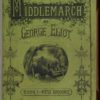
Jules Law, “Victorian Virtual Reality”
This entry considers the lines of continuity between certain aspects of Victorian popular culture and those turn-of-the-21st-century forms of (and aspirations to) real-time, immersive entertainment that we dub “virtual reality.” I argue that virtuality has two aspects, one historical and one phenomenological, and that the middle of the nineteenth century provided templates for both. Like several other scholars (most notably Clayton, Byerly and Plotz), I see the aspiration to virtuality manifested in realist as well as illusionistic genres. I trace virtuality to the Benjaminian concept of the “aura,” but offer a new reading of that term as an historical phase (with a terminal point) rather than as an historically produced essence.
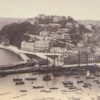
Troy J. Bassett, “‘More than a Bookseller’: Iredale’s Library as the Center of Provincial Literary Life”
Andrew Iredale welcomed Her Royal Highness Princess Victoria and her cousins to his library in Toquay, Devon on 1 September 1898 where the group bought books and photographs. Founded by Iredale in 1872, Iredale’s Library became the “centre of literary life” in the seaside resort community well into the twentieth century. This article considers the circulating library’s role in the community: in addition to selling and lending books, the library served as a place for public and private meetings, third-party business transactions, and interpersonal networking. As the history of Iredale’s Library illustrates, provincial circulating libraries played a vital role in communities well beyond their money-making operations.
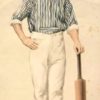
Joanne Wilkes, “The Implications of the Cricket Match in Anthony Trollope’s The Fixed Period (1882)”
Anthony Trollope’s late novel The Fixed Period (1882), set a century in the future in a fictional South Pacific island, has often puzzled readers. It deals with a policy of compulsory euthanasia in the politically independent island of Britannula, a policy that is overturned when the island is taken over by Britain. My article aims to explain an odd interlude in the novel: a cricket match in Britannula between a local and an English team. Drawing on the history of cricket matches between England and its antipodean colonies around the time of the novel’s composition, I argue that the cricketing interlude serves to highlight the text’s take on the Britannulans. This community, living a hundred years in the future, claims to be autonomous, but it possesses a mindset still governed by a sense of Britain as the “mother country.” Hence Trollope emphasizes how difficult it is for settler societies to shake off such attitudes and ties.
